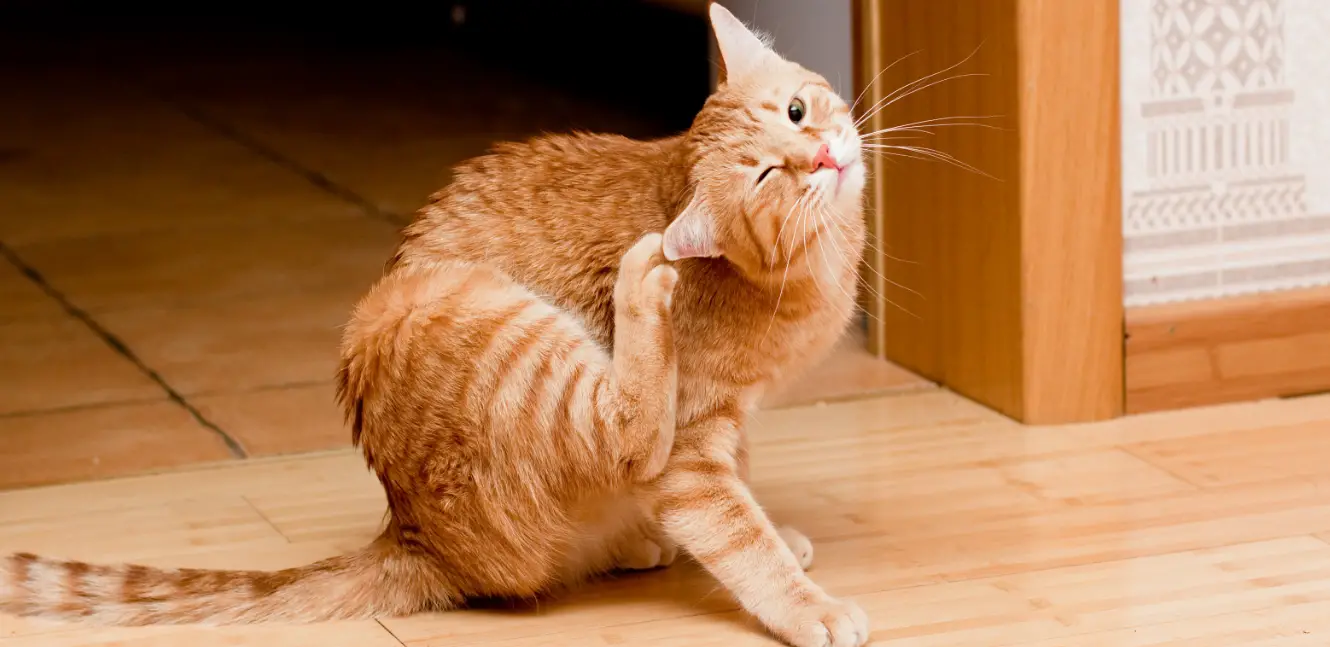To quickly get rid of fleas on your cat, you should start by choosing the cat flea medicine that’s not only suitable for your cat but will also last and break their life cycles; then comes the deep cleaning and disinfection of your cat’s environment, your house and furniture, and even your backyard to prevent the return of fleas.
If you don’t have the time to use natural ways to fight these parasites, here are the 5 steps you need to follow to eliminate fleas from your cat quickly and effectively:
- What kills fleas on cats instantly?
- how long does it take to get rid of fleas on a cat?
- How to quickly get rid of Fleas on your cat? step-by-step
- 1- Start by flea-treating your cat
- 2- Defleaing your cat’s living space
- 3- Flea treatment for the whole house
- 4- Flea treating your backyard
- 5- How to prevent fleas from returning to your cat?
- Final thoughts
What kills fleas on cats instantly?
NEXTSTAR Flea & Tick Topical for Cats is a flea medicine made by CAPSTAR that will start killing fleas on your cat within 15 minutes. There’s also Comfortis (spinosad) Chewable tablet that will get results in just 30 minutes.
But it will be better if you start by flea combing your cat and use spot on flea treatments like Advantage and Frontline, proven to be safer, your cat won’t need to eat any medication to get protected from fleas since these treatments are external. They will start getting results usually within 24 hours after using them. Remember, never give your cat two different flea medicine at the same time!
how long does it take to get rid of fleas on a cat?
If you give your cat an oral flea treatment like COMFORTIS, the fleas will start to fall off and die just half an hour later, whereas most other topical (on spot) flea treatments only have the desired effect after 24 hours, and will kill the fleas just 3 to 5 minutes after they bite your cat.
How to quickly get rid of Fleas on your cat? step-by-step
1- Start by flea-treating your cat

Getting your cat ready for flea treatment:
You’ll leave your cat unbathed for 2 days to prepare him for the Spot-on flea treatment and restrict his movements to a single room in the house as soon as you notice that he has fleas, here are the main symptoms:
- Unusual and frequent scratching followed by excessive grooming
- Bold spots and fur loss
- Scratches, wounds, and lesions
- Inappence and lethargy
- Sudden agitation and sense of discomfort
Cats can get fleas in many ways, and to spot them, simply pull back your cat’s hair to reveal its skin and you’ll see the flea dust and even the fleas (little black bugs); also, be prepared to monitor your cat for at least 48 hours after treatment to react quickly if you notice any side effects.
Choosing the suitable cat flea treatment:
It’s very important to choose a suitable flea medicine for your cat to get rid of fleas completely. There are several cat flea medicines on the market, each with its own advantages and weaknesses.
If it’s just a question of treating fleas, I’d recommend you start with a spot-on cat flea treatment. Two brands stand out from the crowd, Advantage2, and Frontline Plus. They come in tubes that you apply between your cat’s shoulders to immunize him against adult fleas for almost a month.
Advantage has the additional advantage of attacking fleas at almost every stage of their life cycle since it contains an active agent considered to be an insect growth regulator.
I wouldn’t recommend using a flea collar, even the well-publicized ones such as Seresto (a local effect just around your cat’s neck, not to mention other allergy and contamination problems) or oral flea treatment, as their efficacy is very relative and their effect rarely exceeds two weeks, not to mention their effectiveness.
But if for any reason you’d prefer to choose an Oral flea treatment, I’d recommend Sentinel brand tablets.
Treating all your other pets against fleas:
To quickly get rid of fleas on your cat, you also need to treat all your other pets and their respective spaces at the same time, so that fleas don’t move from one host to another and come back the next day on your cat’s back, making all your efforts to get rid of this parasite pointless.
2- Defleaing your cat’s living space
When you find fleas on your cat, you should know that they only represent 5% of the total flea infection, so here are the other life stages of fleas:
- 50% of flea infection is in the form of eggs as large as grains of sand.
- 35% in the form of flea larvae 2mm long
- 10% is in the form of flea pupae (very resistant at this stage of their lives).
So you need to know that over 90% of future fleas are scattered in every corner where your cat is accustomed to going, napping, playing, on your bed, in his bed, in your carpet …
Laundering your cat bedding, eventual clothes, and toys … at high temperatures is one of the most effective ways to eliminate fleas, their eggs, and larvae.
Things you suspect contain flea eggs or larvae but can’t wash, you can just place in a bag and freeze them for 48 hours.
After that Essential oils are a good natural repellent for fleas, especially lavender, peppermint, and eucalyptus essential oils.
You can also use homemade flea sprays (mix white vinegar, drops of dish soap and water).
You should therefore try to clean and disinfect any object that has been in contact with your cat, especially to eliminate flea eggs, their cocoons, and larvae, which can remain alive for several months, feeding on any organic waste and waiting for the right moment to complete their development cycle and climb back on your cat’s back at the first opportunity to re-launch the infection, hence the need for a continuous and regular preventive effort.
3- Flea treatment for the whole house
Treating your cat and its environment for fleas isn’t enough to get rid of them quickly.
This is not to scare you, but once you detect fleas on your cat, be aware that the females generally start laying eggs just 48 hours after biting him.
A female flea lays an average of 40 to 50 eggs a day, which your cat will then disseminate throughout the house by scratching.
So you need to go through this stage of disinfecting your home to get rid of these flea eggs, pupae and larvae as efficiently as possible.
Check for live fleas and flea dirt by wearing white socks, flea dirt looks like coffee powder but turns reddish when put in water.
- Start by inspecting your carpets and rugs and treat them
- Sanitize all your pet’s bedding and crates
- Hot-wash all your sheets, bedspreads, the clothes you usually wear when playing with your cat, and all your socks…
- Be sure to check all dark, damp corners, like any upholstered furniture, and especially all places where your cat usually naps.
You should also know that when fleas are in the cocoon stage(pupae), it’s difficult to eliminate them, so you need follow-up treatments when they metamorphose, after 5 to 10 days, to be sure of eliminating them.
Regular Cleaning and Vacuuming:
One of the most effective ways to control fleas is to vacuum regularly and energetically because your carpet is the area that will contain the highest percentage of flea larvae, pupa, and eggs.
Don’t forget to clean your canister with hot water and soap and dispose of the dust bag immediately in an outside trashcan.
Then treat your house and furniture with either a product like Novacide flea and tick killer (it contains an insect growth regulator that prevents flea eggs from hatching and their larvae from becoming adults), or a home-made spray and natural repellent (less effective).
This disinfection operation should be repeated at least every two to three months, especially if you live in a humid area with a mild climate.
4- Flea treating your backyard
Your backyard also needs to be treated against fleas. Start by doing a quick clean-up, picking up dead leaves, bits of wood, and objects lying around.
You can then use a disinfectant to kill these fleas and prevent them from invading your home at the slightest opportunity. Do the same in your balconies and terraces and any corners visited by your cat or other pets.
Finally, You need to be aware that your cat can get fleas even during the winter, so you need to remain vigilant and continue the treatment all year round.
5- How to prevent fleas from returning to your cat?
Cat flea treatments usually only last a month, so you need to repeat the treatment every 28 days. This will depend on the flea medicine.
Also remember to avoid bringing flea eggs back under your shoe or in your clothes every time you take your pet outside, such as to the park, and to avoid your cat coming into contact with other animals such as squirrels, raccoons, other cats, etc.
Vacuum cleaners and flea sprays are your friends in the ongoing battle against fleas, so remember to vacuum more often, especially during the season when fleas proliferate most, i.e. summer and late autumn.
Finally, always remember to inspect your cat’s fur, as fleas are easier to control and eradicate if you discover them at the start of the infection.
Final thoughts
Getting rid of fleas on your cat means treating the whole house, and always being careful not to provoke the infection yourself.
Always remember to disinfect your cat’s surroundings immediately after administering the flea treatment.


